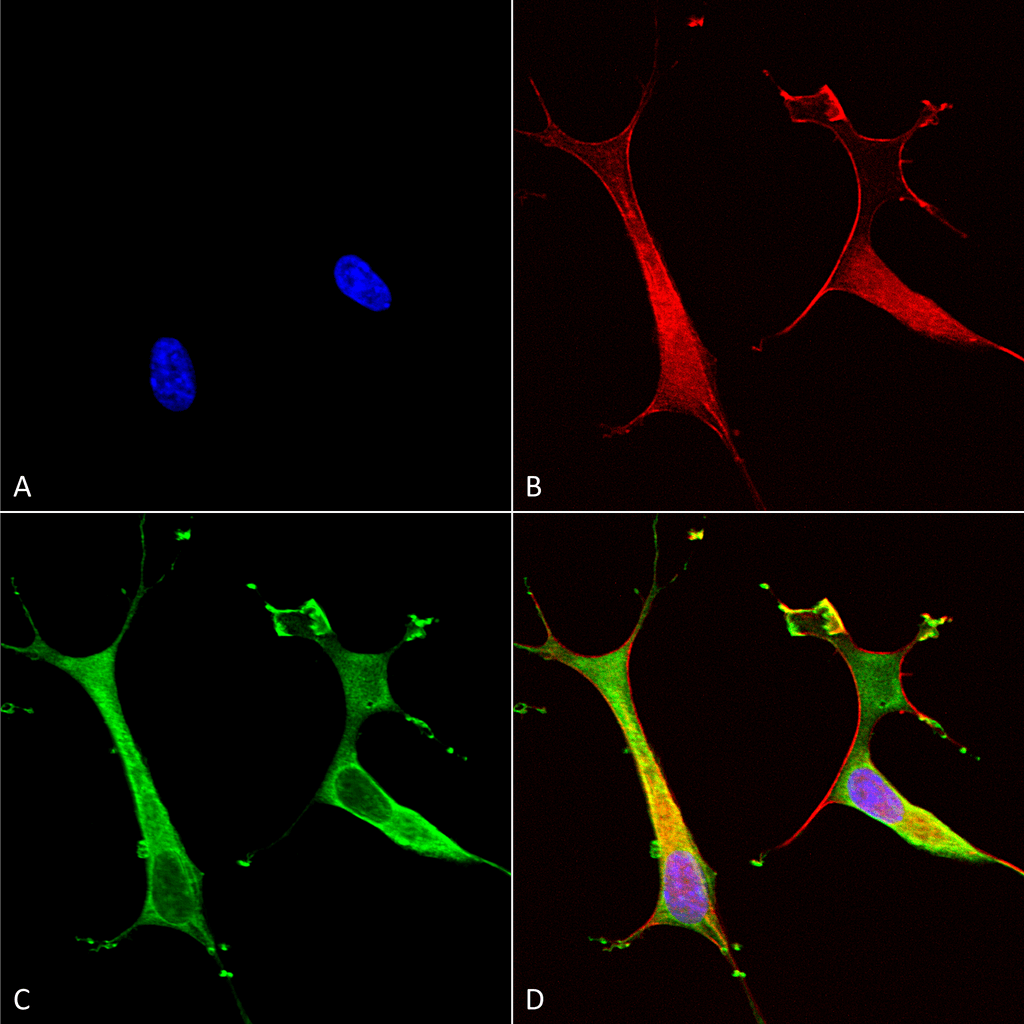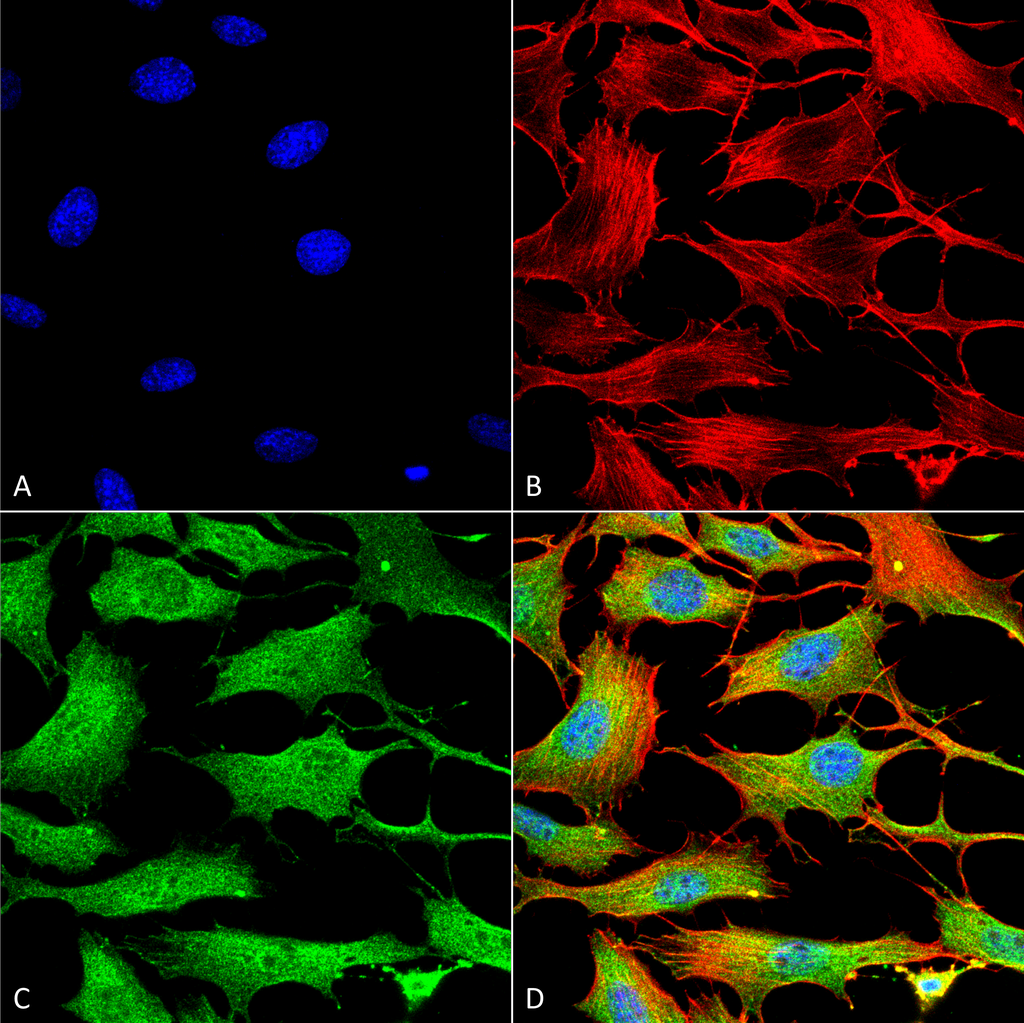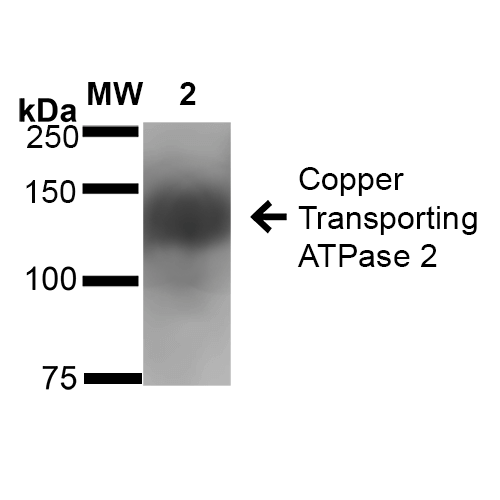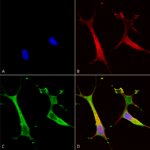Properties
| Storage Buffer | PBS pH7.4, 50% glycerol, 0.09% sodium azide *Storage buffer may change when conjugated |
| Storage Temperature | -20ºC, Conjugated antibodies should be stored according to the product label |
| Shipping Temperature | Blue Ice or 4ºC |
| Purification | Protein G Purified |
| Clonality | Monoclonal |
| Clone Number | L62/29 (Formerly sold as S62-29) |
| Isotype | IgG1 |
| Specificity | Detects ~160kDa in rat brain membrane preparations. |
| Cite This Product | StressMarq Biosciences Cat# SMC-399, RRID: AB_11232610 |
| Certificate of Analysis | 1 µg/ml of SMC-399 was sufficient for detection of Copper-transporting ATPase2 in 20 µg of rat brain lysate by colorimetric immunoblot analysis using Goat IgG:HRP as the secondary antibody. |
Biological Description
| Alternative Names | ATP7B Antibody, ATPase Cu++ transporting beta polypeptide Antibody, ATPase Cu(2+) transporting beta polypeptide Antibody, Copper pump 2 Antibody, Copper transporting ATPase 2 Antibody, PWD Antibody, Toxic milk Antibody, tx Antibody, WC1 Antibody, WD Antibody, Wilson disease associated protein Antibody, WND Antibody, WND/140 kDa Antibody |
| Research Areas | Cell Signaling, Ion Channels, Neuroscience |
| Cellular Localization | Cytoplasm, Golgi apparatus, Mitochondrion, Trans-golgi network membrane |
| Accession Number | NP_000044.2 |
| Gene ID | 540 |
| Swiss Prot | B7ZLR4 |
| Scientific Background | The copper efflux transporters ATP7A and ATP7B sequester intracellular copper into the vesicular secretory pathway for export from the cell. ATP7b is an important protein for copper transport and elimination of excess copper from the body. ATP7b transports metals in and out of cells using ATP. There are 3 known isoforms of the ATP7b gene; A is found in the liver, kidney, and brain, the shorter form B is found in brain tissue, and the third isoform, known as WND/140 KDA is found in mitochondria. Mutations in the ATP7b gene can cause Wilson's disease, an inherited disorder causing copper poisoning in the brain and liver, characterized by neurological symptoms and hepatic damage. |
| References |
1. Tanzi R.E., et al. (1993) Nature Genetics. 5: 344-350. 2. Ghr/nlm.gov/gene/ATP7B |
Product Images

Immunocytochemistry/Immunofluorescence analysis using Mouse Anti-Copper Transporting ATPase 2 Monoclonal Antibody, Clone L62/29 (SMC-399). Tissue: Neuroblastoma cells (SH-SY5Y). Species: Human. Fixation: 4% PFA for 15 min. Primary Antibody: Mouse Anti-Copper Transporting ATPase 2 Monoclonal Antibody (SMC-399) at 1:100 for overnight at 4°C with slow rocking. Secondary Antibody: AlexaFluor 488 at 1:1000 for 1 hour at RT. Counterstain: Phalloidin-iFluor 647 (red) F-Actin stain; Hoechst (blue) nuclear stain at 1:800, 1.6mM for 20 min at RT. (A) Hoechst (blue) nuclear stain. (B) Phalloidin-iFluor 647 (red) F-Actin stain. (C) Copper Transporting ATPase 2 Antibody (D) Composite.

Immunocytochemistry/Immunofluorescence analysis using Mouse Anti-Copper Transporting ATPase 2 Monoclonal Antibody, Clone L62/29 (SMC-399). Tissue: NIH 3T3 (NIH 3T3). Species: Mouse. Fixation: 4% Formaldehyde for 15 min at RT. Primary Antibody: Mouse Anti-Copper Transporting ATPase 2 Monoclonal Antibody (SMC-399) at 1:100 for 60 min at RT. Secondary Antibody: Goat Anti-Mouse ATTO 488 at 1:200 for 60 min at RT. Counterstain: Phalloidin Texas Red F-Actin stain; DAPI (blue) nuclear stain at 1:1000, 1:5000 for 60 min at RT, 5 min at RT. Localization: Cytoplasm . Magnification: 60X. (A) DAPI (blue) nuclear stain. (B) Phalloidin Texas Red F-Actin stain. (C) Copper Transporting ATPase 2 Antibody. (D) Composite.

Western Blot analysis of Rat Brain Membrane showing detection of ~160 kDa Copper Transporting ATPase 2 protein using Mouse Anti-Copper Transporting ATPase 2 Monoclonal Antibody, Clone L62/29 (SMC-399). Lane 1: Molecular Weight Ladder (MW). Lane 2: Rat Brain Membrane cell lysate. Load: 20 µg. Block: 2% BSA and 2% Skim Milk in 1X TBST. Primary Antibody: Mouse Anti-Copper Transporting ATPase 2 Monoclonal Antibody (SMC-399) at 1:1000 for 16 hours at 4°C. Secondary Antibody: Goat Anti-Mouse IgG: HRP at 1:100 for 60 min at RT. Color Development: ECL solution for 6 min in RT. Predicted/Observed Size: ~160 kDa.






















Reviews
There are no reviews yet.